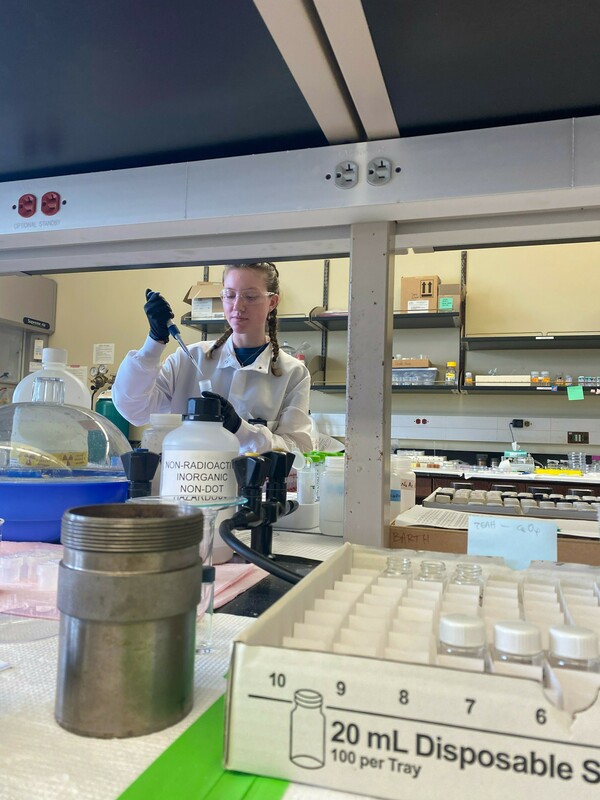
In January 2023, the Center for Sustainable Energy (ND Energy) at Notre Dame announced seven undergraduate students as recipients of a Vincent P. Slatt Fellowship for Undergraduate Research in Energy Systems and Processes. Slatt scholars who are wrapping up their research projects this spring took a few minutes out of their schedules to chat with members of the Student Energy Board Communications Team (SEBCT) about their research experience.
Below are highlights of the conversations between SEBCT members and Konstantin Bauer, Ryan Bencivengo, Eva Homberger, and Zachary Muetzel.
Konstantin Bauer ’25
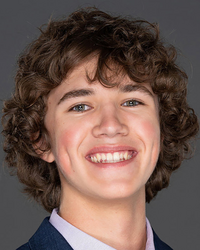
Physics major and Glynn Family Honors Scholar
Slatt Project: “Combustion Synthesis and Characterization of Thorium Dioxide” in the laboratory of Khachatur Manukyan, associate research professor, Department of Physics and Astronomy. This project explores the possibility and feasibility of preparing amorphous thorium dioxide by using a rapid and energy-efficient combustion synthesis method to decrease sintering temperatures. Specifically, Bauer conducts thermal analyses of reactive solutions producing thorium dioxide, studies the combustion synthesis of thorium dioxide, and characterizes prepared thorium dioxide.
This interview was conducted by Raleigh Kuipers ’25, SEBCT member, majoring in Global Affairs and Spanish with minors in Civil & Human Rights and European Studies.
Kuipers: What is the research you are currently working on?
Bauer: Right now, we are trying to produce amorphous thorium oxide solutions, so day-to-day, we make some thorium concentrations with differing fuel to oxidizer ratios and after we make them, we perform combustion synthesis on them. This, basically, heats them up to around 300 C so they reach a certain temperature to combust and form a powder. We analyze that powder to see how crystalline or amorphous it is, and we want to produce more amorphous powder.
Kuipers: What is the most important takeaway from your research or the Slatt Fellowship in general?
Bauer: This research has been a bit different from what I have done previously. It definitely takes a lot more patience since we are often waiting for a reaction to occur or for something to dissolve in a solution, so it is important to be patient and thorough. It is also a lot more about being careful in making the solutions and making sure you are using the right volumes of thorium and solvents.
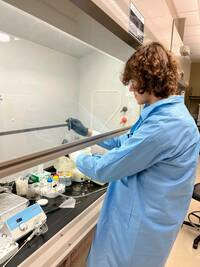
Kuipers: What did your previous research entail?
Bauer: I have been working with my current research advisor since January of last year. Last year and over the summer, we were working on a project analyzing the crystallization of an iron-boron-silicon metallic glass. Metallic glass is an amorphous metal alloy. We were exposing it to high temperatures using a differential scanning calorimeter and exposing the samples to an argon-ion beam because you can crystallize the samples through those two methods. We analyzed how they crystalized, what energies they were releasing, and how the samples formed in different ways with different properties.
Kuipers: What is the purpose or goal of your current research?
Bauer: Right now, most nuclear reactors are using uranium fuel pellets to produce heat, and those are okay but they produce a lot of toxic fuel. Uranium is not super abundant in the Earth’s crust, but thorium is a lot more abundant and does not produce as toxic of fuel. If we were able to devise a method to use thorium instead of uranium for reactors, it would be cleaner and more cost-effective. The problem is that now, to create thorium fuel pellets, you need to use very high temperatures, which is an energy-intensive process, and that uses crystalline thorium. We are trying to produce amorphous thorium oxide that can be used to produce fuel pellets at a lower temperature, requiring a lower energy expenditure.
Kuipers: How has your Slatt research prepared you for careers or research in the future?
Bauer: It has definitely given me good experience. This semester I have been doing a lot more chemistry than in the past—making solutions, learning about combustion synthesis—so it has been a little more chemistry-oriented, which has given me some good experience in that field, which I hadn’t really done much with in the past. It has also given me more skills that I will need to be successful as a researcher and to discern what I want to do in the future with research.
Kuipers: What is your favorite part of the fellowship?
Bauer: This semester of research has been very hands-on and I have been able to work one-on-one with a graduate student, so I have been learning a lot through that. It is very nice to have someone to ask questions to and to be able to learn in a hands-on way.
Kuipers: Why should other students consider the Slatt Fellowship?
Bauer: Especially for science or engineering students, doing undergraduate research is a very good experience. It gives you exposure to actual science rather than just learning about it in the classroom. Learning what actual scientists and innovators in the field do is very helpful, and the Slatt Fellowship specifically connects you with innovative projects. I am very interested in energy innovation and the Slatt Fellowship connects you to projects that are important for our future development, fighting the climate crisis, and developing energy-efficient technologies.
Ryan Bencivengo ‘25
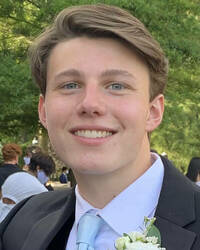
Aerospace Engineering major with a minor in Engineering Corporate Practice
Slatt Project: “Optimization of Energy Deposition Pattern at Plasma-Assisted Combustion” in the laboratory of Sergey Leonov, research professor, Department of Aerospace and Mechanical Engineering. This project tests the viability of plasma-based combustion and flame-holding in supersonic flow, where the successful implementation could lead to more efficient scramjet engines and an expansion of the capabilities of hypersonic vehicles in general. Bencivengo specifically works on the circuitry to trigger and maintains the plasma for testing.
This interview was conducted by Raleigh Kuipers ’25, SEBCT member, majoring in Global Affairs and Spanish with minors in Civil & Human Rights and European Studies.
Kuipers: What is the research you are currently working on?
Bencivengo: My research project is the assembly of a high-voltage power supply with the end goal of ignition and maintenance of plasma within a wind tunnel. Within this assembly, I have been working on thermal management problems.
Kuipers: What is the most important takeaway from your research or the Slatt Fellowship in general?
Bencivengo: My most important takeaway from my research through the Slatt Fellowship is that science and progress is such a collaborative pursuit. I have had the opportunity to work around and with people that I never would have been able to without the Slatt Fellowship, and I have been able to learn a lot from them.


Kuipers: How has your Slatt research prepared you for careers or research in the future?
Bencivengo: This research made possible through the Slatt Fellowship has allowed me to work in a hands-on lab, gaining experience with state-of-the-art technology. Through this, I have gained more exposure into the field of hypersonics, an advancing field that I hope to work in some day.
Kuipers: What is your favorite part of the fellowship?
Bencivengo: My favorite part of the fellowship is the opportunity to potentially travel to a conference in the future and present the results of the research that we have been working on.
Kuipers: Why should other students consider the Slatt Fellowship?
Bencivengo: I believe other students should consider the Slatt Fellowship because it allows them the opportunity to work on interesting projects that could have meaningful impacts on the future of energy, while also allowing them to gain experience in unique, groundbreaking fields of science or engineering.
Eva Homberger ’24

Mechanical Engineering major with a minor in Energy Studies as well as a Sorin Scholar
Slatt Project: “Batch Sorption of U60 Nanocluster to Muscovite in the Presence of Electrolytes” in the laboratory of Peter C. Burns, Henry J. Massman Professor of Civil and Environmental Engineering and Earth Sciences. This project is a batch sorption experiment that builds upon the line of research studying the behavior of uranyl peroxide nanocluster U60 in the presence of minerals, specifically examining the sorption of U60 to muscovite. Homberger is gaining insight into the behavior of U60, which is critical to understanding proper nuclear waste treatment strategies and ensuring the long-term sustainability of nuclear energy.
This story was written by Samantha Sebastion '26, SEBCT member, majoring in Electrical Engineering.
Meet Eva Homberger, a junior mechanical engineering major at the University of Notre Dame, who finds her home in three places: the suburbs of Chicago, Cavanaugh Hall, and a research lab in Stinson-Remick Hall of Engineering.
As a recipient of a Slatt Fellowship, Homberger is spending the spring semester working on actinide materials in the laboratory of Peter C. Burns, the Henry J. Massman Professor of Civil and Environmental Engineering and Earth Sciences and director of ND Energy. She is specifically studying the interaction between U60 (a uranyl peroxide nanocluster) and muscovite (a type of mineral) and how an array of factors such as pH and cations influence the nanocluster’s sorption.
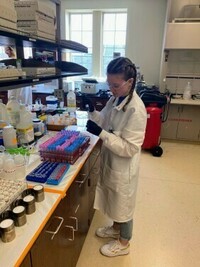
With the urgency to transition to clean energy, Homberger believes nuclear energy plays a huge role in society. She points out a few issues though with “one being the waste treatment” and since “U60 has the potential to form in waste [in] current or future sites …, sorption is important to understand, as it is one of the best ways to prevent radionuclide mobility in the environment.”
While there are dozens of research papers and studies on it, many of which Homberger has read for personal interest, she manages to immerse herself in the topic of nuclear energy through first-hand experiences in the laboratory.
As an undergraduate researcher for more than two years, Homberger shares the struggles of how “research never goes according to plan.” She recalls several times encountering broken instruments or unexpected results, which did not dissuade her from spending several hours a week working with the nanoclusters and focusing her interest on nuclear engineering, which she plans to pursue during graduate studies.

Homberger’s overall experience from the Slatt research fellowship allows her to “have more leadership on a project, to make decisions about how the processes are implemented, [such as with managing] funding, and to eventually present her research at a conference.”
She recommends the Slatt research fellowship especially to those who are interested in pursuing a graduate degree, as the experience encompasses all aspects of project planning, making recommendations, and executing the work. With all the technical learning and scientific reading students do, she stresses, “Being able to actually work in a laboratory gives you a much better understanding and practical knowledge of whatever it is you are studying.”
Suffice it to say, if Homberger is not in the Windy City or sharing laughs with her friends in Cavanaugh Hall, she is in the Burns lab closely studying the nanoclusters and achieving her ambition to create a cleaner energy future through nuclear energy.
(Photos: Eva Homberger is pipetting from a stock solution containing U60 clusters that she will add to a reaction containing muscovite and electrolytes to analyze the sorption reaction.)
Zachary Muetzel ’23

Chemical Engineering major
Slatt Project: “Development of 3D-printed Modules to Evaluate the Performance of Photoresponsive Polymer Membranes” in the laboratory of William Phillip, Rooney Family Collegiate Chair of Engineering and associate professor, Department of Chemical and Biomolecular Engineering. Muetzel is studying the development of unique 3D-printed modules to evaluate the performance of photoresponsive polymer membranes. Photoresponsive membranes are those that undergo chemical changes when exposed to light and show promise in separation applications due to their increased versatility and flexibility in comparison to conventional membranes.
This interview was conducted by Grace Collins ’25, SEBCT member, majoring in Economics and Sociology with minors in Energy Studies and Data Science.
Collins: What is the research you are currently working on?
Muetzel: The proposed research is dedicated to developing novel stirred cell designs and producing them using 3D printing. This new stirred cell incorporates LED lights to test photoresponsive membranes, a new class of membranes that change their performance when hit with light.
Collins: What is the most important takeaway from your research or the Slatt Fellowship in general?
Muetzel: The realization of the proposed device discussed above is the largest takeaway. This allows for the testing of photoresponsive membranes and expands the capabilities of the lab.
Collins: How has your Slatt research prepared you for careers or research in the future?
Muetzel: Learning how to problem solve and adapt a design to fit the needs of the end use is critical in future career work. In addition, the ability to combine analytical methods with creativity is also important.
Collins: What is your favorite part of the Slatt Fellowship?
Muetzel: Having the opportunity to work with Notre Dame professors and graduate students and solving problems with no known solutions is exciting. This difference makes it a fun challenge and different from normal coursework.
Collins: Why should other students consider the Slatt Fellowship?
Muetzel: If you are interested in getting involved in ND Energy research on campus and being paid for it, consider the Slatt Fellowship.
Questions regarding the Vincent P. Slatt Fellowship for Undergraduate Research in Energy Systems and Processes should be directed to Barbara Villarosa at villarosa.2@nd.edu.
Originally published by at energy.nd.edu on April 30, 2023.